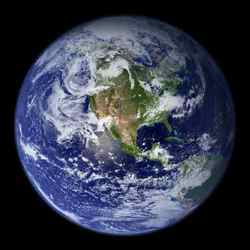
Western Hemisphere. Image credit: NASA Click to enlarge
Open University researchers have uncovered startling new evidence about an extreme period of a sudden, fatal dose of global warming some 180 million years ago during the time of the dinosaurs. The scientists’ findings could provide vital clues about climate change happening today and in the future.
The OU Department of Earth Sciences team, PhD student Dave Kemp and supervisors Drs. Angela Coe and Anthony Cohen, along with Dr. Lorenz Schwark of the University of Cologne, discovered evidence suggesting that vast amounts of methane gas were released to the atmosphere in three massive ‘methane burps’ or pulses. The addition of methane, a greenhouse gas, to the atmosphere had a severe impact on the environment, warming Earth about 10 C, and resulting in the extinction of a large number of species on land and in the oceans.
Dr Angela Coe says: “We’ve known about this event for a few years through earlier work by our team and others, but there’s been a great deal of uncertainty about its precise size, duration, and underlying cause. What our present study shows is that this methane release was not just one event, but 3 consecutive pulses. Importantly, our data demonstrate that each individual pulse was very rapid. Also, whilst the methane release was very quick, we’ve found that the recovery took much longer, occurring over a few hundred thousand years”.
The methane came from gas hydrate, a frozen mixture of water and methane found in huge quantities on the seabed. This hydrate suddenly melted, allowing the methane to escape. The OU researchers based their findings on geochemical analyses of mudrocks that are preserved along the Yorkshire coast near Whitby, UK, and date from the Jurassic Period of geological time.
Dave Kemp, whose PhD is funded by the Natural Environment Research Council (NERC), says: “The methane was released because slight wobbles in the Earth’s orbit periodically bring our planet closer to the Sun, warming the oceans sufficiently to melt the vast reserves of hydrate. We believe that this effect was compounded by warming from greenhouse gases from volcanoes. After the methane was released into the atmosphere from the seabed it reacted rapidly with oxygen to form carbon dioxide. Carbon dioxide is also a powerful greenhouse gas that persists in the atmosphere for many hundreds of years, and it was this gas which caused such a massive global warming effect”.
Dr Anthony Cohen adds: “One of the most important aspects of the study is that it provides an accurate timescale for how the Earth, and life, reacted to a sudden increase in atmospheric carbon dioxide. Today we are releasing large amounts of carbon dioxide to the atmosphere, primarily through the burning of fossil fuels. It is possible that the rate at which carbon dioxide is being added to the atmosphere now actually outstrips the rate at which it was added 180 million years ago. Given that the effects were so devastating then, it is extremely important to understand the details of past events in order to better comprehend present-day climate change. With this information, we are better informed about what action needs to be taken to mitigate or avoid some of the potential detrimental future effects”.
